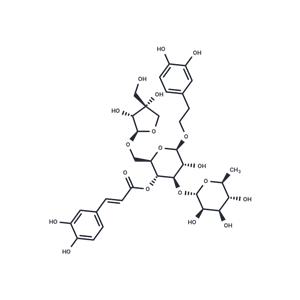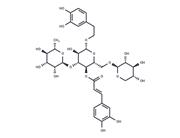| Name | Forsythoside B |
| Description | Forsythoside B binds to LPS and reduces the biological activity of serum LPS, and inhibits NF-κB activation. Forsythoside B inhibits the inflammatory response and has antioxidant properties. Potent neuroprotective effects with a favorable therapeutic time-window, reduce of cerebral ischemia and reperfusion injury degree, attenuating blood-brain barrier (BBB) breakdown; Rescued cardiac function from I/R injury. Forsythoside B has antisepsis effect, is mediated by decreasing local and systemic levels of a wide spectrum of inflammatory mediators. |
| Cell Research | Forsythoside B is dissolved in sterile saline solution and added to the medium at various concentrations (from 0.1 to 10 μM) and incubated with LPS stimulated RAW264.7 cells. Cell-free supernatants are collected after Forsythoside B treatment for 24 h. Cell viability is assessed by measuring lactate dehydrogenase (LDH) in the medium[1]. |
| In vitro | Forsythoside B down-regulates the levels of TNF-α, IL-6 and high-mobility group-box 1 protein (HMGB1) in lipopolysaccharide (LPS)-stimulated RAW264.7 cells, inhibits the IκB kinase (IKK) pathway and modulated nuclear factor (NF)- κB in a concentration-dependently manner[1]. |
| In vivo | Intravenous administration of forsythoside B, either alone or in combination with imipenem, significantly diminishes the serum concentrations of TNF-α, IL-6, HMGB1, TREM-1, and endotoxin, while simultaneously increasing the level of IL-10. It also decreases myeloperoxidase (MPO) activity in the lung, liver, and small intestine[1]. Administered at dosages exceeding 8 mg/kg, forsythoside B exhibits considerable neuroprotective effects in rats subjected to cerebral ischemia and reperfusion, with notable efficacy even when administration is delayed by 1 h, 3 h, or 5 h. It reduces brain infarct size and edema, lowers cerebral Evans blue dye leakage and MPO activity, and inhibits expression of cerebral phosphor-IκB-α and NF-κB[2]. Furthermore, forsythoside B at 20 mg/kg significantly enhances myocardial function, evidenced by improved left ventricular systolic pressure (LVSP) and maximal rate of pressure change (±dp/dt(max)), alongside a reduction in myocardial infarct volume, serum Tn-T, TNF-alpha, IL-6 levels, myocardial malondialdehyde (MDA) content, and MPO activity. It also downregulates the protein expression of HMGB1, phosphor-IκB-α, and phosphor-NF-κB, along with mitigating the decrease in superoxide dismutase (SOD) and glutathione peroxidase (GPx) activities[3]. Additionally, forsythoside B, with or without imipenem, lowers CLP-induced mortality rates in rats. |
| Storage | keep away from direct sunlight,keep away from moisture | Powder: -20°C for 3 years | In solvent: -80°C for 1 year | Shipping with blue ice/Shipping at ambient temperature. |
| Solubility Information | 10% DMSO+40% PEG300+5% Tween 80+45% Saline : 2 mg/mL (2.64 mM), Sonication is recommended.
DMSO : 55 mg/mL (72.68 mM), Sonication is recommended.
|
| Keywords | Tumor Necrosis Factor Receptor | TNFR | TNF Receptor | Nuclear factor-κB | Nuclear factor-kappaB | NF-κB | NFκB | NF-kB | NFkB | Inhibitor | inhibit | Forsythoside B |
| Inhibitors Related | Naringin dihydrochalcone | Lidocaine | Methylamine HCl | Diethylmaleate | Glucosamine | sodium lauroyl-α-hydroxyethyl sulfonate | Lidocaine hydrochloride | Apremilast | N,N-Dimethylacetamide | Indole-3-carbinol | Lenalidomide | Diallyl disulfide |
| Related Compound Libraries | Anti-Tumor Natural Product Library | Polyphenolic Natural Product Library | Traditional Chinese Medicine Monomer Library | Bioactive Compound Library | Membrane Protein-targeted Compound Library | Natural Product Library | Miao medicine Compound Library | Anti-Inflammatory Traditional Chinese Medicine Compound Library | Neuroprotective Compound Library | Natural Product Library for HTS | Anti-Aging Compound Library | Ancient Chinese Classical Formulas Compound Library |

 United States
United States






